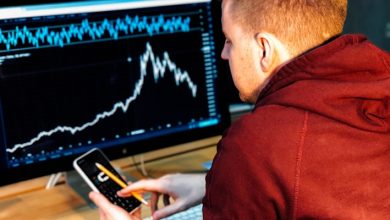The Risks and Rewards of Margin Trading in Cryptocurrency

- Understanding Margin Trading in Cryptocurrency
- Managing Risk: Tips for Margin Trading in Crypto
- The Benefits of Margin Trading in the Cryptocurrency Market
- Common Mistakes to Avoid in Margin Trading
- Exploring the Volatility of Margin Trading in Cryptocurrency
- Strategies for Success in Margin Trading with Cryptocurrency
Understanding Margin Trading in Cryptocurrency
Margin trading in cryptocurrency involves borrowing funds from a broker or exchange to leverage your trading position. This means you can control a larger position in the market with a smaller amount of capital. While this can potentially lead to higher profits, it also comes with increased risks.
One of the key benefits of margin trading is the ability to amplify your gains. By using leverage, you can increase the size of your trades and potentially earn higher returns. However, it is essential to remember that the same leverage that can amplify your profits can also magnify your losses.
Margin trading is not suitable for everyone, as it requires a good understanding of the market and a high tolerance for risk. It is essential to have a solid trading strategy in place before engaging in margin trading to minimize the potential for significant losses.
Before engaging in margin trading, it is crucial to understand the risks involved fully. Margin trading can result in significant losses, especially if the market moves against your position. It is essential to set stop-loss orders and be prepared to cut your losses if the trade is not going as planned.
Overall, margin trading can be a powerful tool for experienced traders looking to maximize their profits in the cryptocurrency market. However, it is not without its risks, and it is crucial to approach it with caution and a clear understanding of the potential downsides. By carefully managing your risk and staying disciplined in your trading approach, you can potentially reap the rewards of margin trading while minimizing the associated risks.
Managing Risk: Tips for Margin Trading in Crypto
When it comes to margin trading in cryptocurrency, managing risk is essential to avoid significant losses. Here are some tips to help you navigate the risks associated with margin trading:
- Start small: Begin with a small margin and gradually increase it as you gain more experience and confidence in your trading strategy.
- Set stop-loss orders: Use stop-loss orders to automatically sell your assets if the price drops below a certain point, limiting your losses.
- Diversify your portfolio: Spread your investments across different cryptocurrencies to reduce the impact of a single asset’s price fluctuations.
- Stay informed: Keep up to date with market trends, news, and events that could impact the value of your investments.
- Avoid emotional trading: Make decisions based on data and analysis rather than emotions like fear or greed.
By following these tips and staying vigilant, you can better manage the risks associated with margin trading in cryptocurrency and increase your chances of success in the volatile crypto market.
The Benefits of Margin Trading in the Cryptocurrency Market
Margin trading in the cryptocurrency market offers several benefits to traders looking to increase their potential profits. By using leverage, traders can amplify their gains without having to commit the full amount of capital required for a trade. This means that even with a small initial investment, traders can access larger positions and potentially earn higher returns.
Another advantage of margin trading is the ability to short sell cryptocurrencies. This means that traders can profit from the price of a cryptocurrency decreasing, as well as increasing. Short selling allows traders to hedge their positions and take advantage of market movements in both directions.
Additionally, margin trading can provide traders with more flexibility and liquidity in the market. By using borrowed funds, traders can take advantage of short-term trading opportunities and react quickly to market changes. This can help traders capitalize on price fluctuations and maximize their profits.
Overall, margin trading can be a powerful tool for experienced traders looking to increase their potential profits in the cryptocurrency market. However, it is important to remember that margin trading also comes with increased risks, so traders should approach it with caution and always use proper risk management strategies.
Common Mistakes to Avoid in Margin Trading
When engaging in margin trading, there are several common mistakes that traders should avoid to minimize risks and maximize potential rewards:
- Overleveraging: One of the most common mistakes in margin trading is overleveraging, which occurs when traders borrow more funds than they can afford to lose. This can lead to significant losses if the market moves against them.
- Ignoring Risk Management: Another common mistake is neglecting proper risk management strategies. Traders should set stop-loss orders and adhere to them to limit potential losses.
- Emotional Trading: Making decisions based on emotions rather than logic is a common pitfall in margin trading. Traders should avoid trading impulsively and stick to their predetermined trading plan.
- Chasing Losses: Trying to recoup losses by taking on more risk can be a dangerous mistake in margin trading. It is essential to accept losses and move on to the next trade without letting emotions cloud judgment.
- Not Understanding Margin Calls: Failing to understand how margin calls work can lead to forced liquidation of assets. Traders should be aware of their margin requirements and have a plan in place to meet them if necessary.
By avoiding these common mistakes and staying disciplined in their trading approach, traders can increase their chances of success in margin trading while minimizing potential risks.
Exploring the Volatility of Margin Trading in Cryptocurrency
Margin trading in cryptocurrency is known for its high volatility, which can lead to significant gains or losses for traders. The use of leverage allows traders to amplify their profits, but it also increases the risk of substantial losses. It is essential for traders to understand the potential risks involved in margin trading before engaging in such activities.
One of the primary risks of margin trading in cryptocurrency is the potential for liquidation. If the value of the assets being traded drops below a certain threshold, the exchange may liquidate the trader’s position to cover the losses. This can result in the loss of the initial investment and any additional funds used as leverage.
Another risk of margin trading is the volatility of the cryptocurrency market itself. Unlike traditional financial markets, the cryptocurrency market is highly unpredictable and can experience extreme price fluctuations in a short period. Traders must be prepared for sudden changes in the market that can result in significant losses.
Additionally, margin trading in cryptocurrency can be influenced by external factors such as regulatory changes, security breaches, and market manipulation. These factors can have a significant impact on the value of cryptocurrencies and the overall stability of the market, leading to increased volatility and risk for margin traders.
Strategies for Success in Margin Trading with Cryptocurrency
When it comes to margin trading with cryptocurrency, there are several strategies that can help maximize your chances of success while minimizing risks. Here are some key strategies to consider:
- 1. Start with a solid understanding of the market trends and the specific cryptocurrency you are trading. Research is key to making informed decisions.
- 2. Set clear stop-loss orders to protect your investment from significant losses in case the market moves against you.
- 3. Diversify your portfolio to spread out risks and avoid putting all your eggs in one basket.
- 4. Keep a close eye on market volatility and be prepared to act quickly to capitalize on opportunities or mitigate losses.
- 5. Consider using leverage wisely, taking into account your risk tolerance and financial situation.
By following these strategies and staying informed about market developments, you can increase your chances of success in margin trading with cryptocurrency. Remember to always trade responsibly and be prepared for both the risks and rewards that come with this type of trading.



